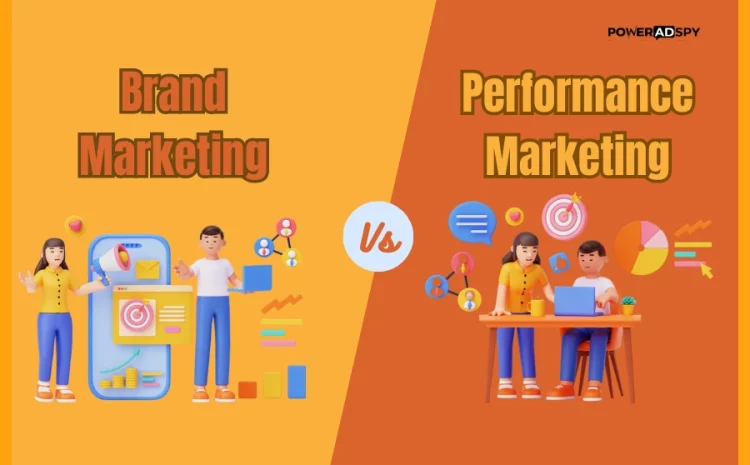What Is Brand Vs. Performance Marketing: A Complete Comparison
In a competitive business, companies seeking a digital edge prioritize digital marketing, where brand vs. performance marketing is the central approach. While both aim at business growth, they significantly differ in methods and objectives.
Brand marketing and performance marketing represent distinct strategies for promoting products or services, each with unique goals, tactics, and metrics.
This comprehensive comparison explores the fundamentals, advantages, drawbacks, and vital distinctions between brand and performance marketing.
Additionally, we will delve into crucial considerations when choosing between the two strategies for seamless integration, acknowledging their pivotal roles in achieving a competitive advantage.
Hit ‘Play’ Button & Tune Into The Blog!
Brand Marketing:
The primary goal of brand marketing is to develop and promote a favorable and enduring image of a company or product. It involves the establishment of a robust brand identity, forging emotional bonds with customers, and nurturing brand loyalty.
Storytelling is a key tactic within this strategy, enabling companies to create profound connections by narrating compelling brand stories that resonate emotionally and shape consumer perceptions. Taking assistance from a brand advertising guide can help you in learning more about these strategies.
An organization’s visual identity, including logos, color palettes, typography, and general design aesthetics, is just as significant. Consider renowned brands such as Coca-Cola or Nike; their instantly recognizable visual elements foster a sense of familiarity and trust. This is the visible characteristic of brand vs. performance marketing.
Advantages And Disadvantages Of Brand Marketing:
There are a few advantages and disadvantages of brand marketing. They are:
Advantages:
- Organizations with a strong brand identity and emotional bonds are more likely to retain customers.
- A positive brand perception enhances the likelihood of customers choosing a brand over competitors, even when prices are higher.
Disadvantages:
- A brand marketing campaign might not produce immediate, measurable results, so calculating ROI is challenging. In contrast to performance marketing, which focuses on instant conversions, brand marketing adopts a more long-term perspective.
- It necessitates consistent investment in building brand awareness, shaping perceptions, and nurturing customer relationships. This prolonged commitment can be demanding for companies seeking quick, measurable results.
- Additionally, brand marketing often entails substantial investments in long-term campaigns such as television commercials, print ads, public relations, and content marketing, which can be financially burdensome, especially for smaller firms or startups with limited budgets.
In brand vs. performance marketing, brand campaigns have both advantages and disadvantages. Performance marketing also has its own merits and demerits. Let us learn about performance marketing and how it can be advantageous in marketing and its disadvantages.
Performance Marketing:
Performance marketing, a data-driven strategy, prioritizes measurable outcomes by focusing on specific actions like clicks, leads, or sales. This approach heavily utilizes online advertising channels, including search engine marketing, social media advertising, and affiliate marketing.
Unlike brand marketing, performance marketing is more immediate and quantifiable. While brand marketing builds long-term trust and loyalty, the emphasis of performance marketing on real-time results distinguishes it in the brand vs. performance marketing landscape.
This strategy aligns with the fast-paced digital landscape, offering businesses a dynamic way to engage audiences and achieve tangible, trackable results.
Merits And Demerits Of Performance Marketing:
Just like brand marketing has its merits and demerits, performance marketing has its advantages and disadvantages. Let us learn about them.
Advantages:
- Performance marketing offers numerous advantages for businesses, notably in delivering a transparent return on investment (ROI) through direct measurement of marketing impact on specific actions or conversions.
- This transparency empowers companies to make informed decisions, optimizing resource allocation.
- Additionally, performance marketing excels in precise targeting and segmentation, enhancing conversion rates, and ensuring efficient resource utilization.
Disadvantages:
- The focus on immediate results can be a drawback, as performance marketing may not cultivate enduring brand awareness and loyalty.
- The strategy demands continuous tracking, optimization, and data analysis for optimal results.
- Marketers must consistently monitor campaign performance, adjust strategies based on data insights, and stay abreast of evolving trends and technologies.
Let us now learn about the basic differences that exist in brand vs. performance marketing.
Brand vs. Performance Marketing: Basic Differences
While both approaches, brand, and performance marketing, bring distinct merits to the table, their fundamental differences set them apart. Brand marketing emphasizes long-term strategies, nurturing trust and loyalty through storytelling and visual identity.
It focuses on creating a lasting positive perception. On the other hand, performance marketing zeroes in on immediate, measurable outcomes, leveraging data-driven strategies for actions like clicks or sales.
The dichotomy of brand vs. performance marketing lies in their contrasting timelines and objectives, providing businesses with varied tools for navigating the competitive digital landscape.
The basic differences that exist between them are as follows:
Strategy And Approach:
The approach and strategy in performance marketing are geared towards immediate and measurable outcomes, targeting specific actions or conversions. Marketers employ data-driven methods, such as optimizing campaigns for efficiency by targeting particular keywords or demographics.
Real-time tracking and analysis enable adjustments for desired results. In contrast, brand marketing adopts a longer-term perspective, aiming to establish and strengthen a positive brand image over time.
Brand marketing recognizes the importance of consistent messaging and experiences to resonate with the target audience in building a robust brand by emphasizing storytelling and emotional connections.
Time Horizon:
The time horizon distinguishes the contrasting philosophies of brand vs. performance marketing. Brand marketing adopts a patient, long-term stance, meticulously crafting a brand image over months or even years. Enhanced brand recognition and loyalty are the fruits, even if they are not immediate.
Conversely, performance marketing is the sprinter, sprinting towards rapid, measurable outcomes. Its focus on short-term goals, often realized within a single campaign duration, facilitates quick returns on investment.
The dichotomy lies in the strategic choice between patiently nurturing a brand’s identity and swiftly achieving tangible results. This juxtaposition of timelines underscores the nuanced interplay of objectives in the ever-evolving landscape of brand versus performance marketing.
Creativity vs. Data Driven In Brand vs. Performance Marketing:
Like an artist’s canvas, brand marketing depends on creativity to captivate an audience through gripping tales and emotive appeals. Effective marketing and effective advertising is a game changer. However, its challenge lies in the intangibility of measurable outcomes, making success more subjective.
On the flip side, performance marketing is the scientist in the equation, relying on data-driven decision-making. Through testing, analytics, and scrutinizing performance data, it fine-tunes campaigns with surgical precision for optimal efficiency.
The balance between unleashing creativity and embracing data forms the crux of the perpetual debate shaping brand vs. performance marketing.
Marketing and advertising strategies play a major role in increasing product sales and customer conversions.
But sometimes, it becomes evident that your advertising ideas and strategy are not performing at their best, and you are out of new ideas for your ad creatives.
What can you do in this situation?
Here, taking assistance from ad spy tools can help you out. One such tool is PowerAdSpy. It has the best features that can enable you to gain ideas and inspiration from the successful ad creatives of your competitors.
Let us learn about this tool in brief.
PowerAdSpy: The Best AI Solution To Your Ad Creative Issues.
PowerAdSpy is a social ads intelligence tool that aids advertisers in enhancing their ad campaigns. It offers valuable insights into the performance of competitors ad campaigns within a specific niche.
The tool enables advertisers to examine different ad types, copies, and visuals, facilitating the identification of high-performing ads. This feature reduces the time and effort required to create a successful advertising campaign.
Advertisers can benefit from PowerAdSpy in several ways:
Gain Insights Into Effective Strategies:
PowerAdSpy offers valuable insights into the success of ad campaigns within a specific niche. It aids advertisers in identifying top-performing ads by allowing them to assess various ad types, copies, and visuals.
Stay Competitive:
The tool enables advertisers to stay ahead of competitors by adapting their marketing strategies based on insights. It provides information on competitors’ techniques, helping advertisers enhance their profitability.
Identify Campaign Targets:
Advertisers can use PowerAdSpy to pinpoint specific targets for their campaigns by taking guidance from competitor’s ads.
Conduct Niche Research:
The tool assists advertisers in comprehensive niche research, providing crucial information for strategic planning.
With these benefits, PowerAdSpy is a suitable display ad spy tool that you can use for your marketing strategy. You get a wide range of ads to select from for your strategy, as more than 350 million ads are in it, and more than 250 ads get added daily. Thus, make it your ad partner and make your ad creation journey easy.
Now that we have learned about this tool- let us continue with our topic on brand vs. performance marketing.
Measurement Of Success:
Success measurement in performance marketing directly impacts the bottom line through specific actions or conversions.
Metrics like click-through rates (CTR), conversion rates, and return on ad spend (ROAS) act as tangible benchmarks for assessing campaign effectiveness, empowering marketers to make data-driven decisions.
In contrast, brand marketing relies on more subjective success measures. While brand awareness, customer sentiment, and brand equity are pivotal, they lack easy quantifiability and might not yield immediate financial impact.
Yet, they play a vital role in shaping brand perception and fostering enduring customer loyalty. Brands engage in market research, analyze customer feedback, and monitor social media sentiment to gauge the effectiveness of their initiatives. It enables informed decisions for refining strategies and enhancing customer experiences.
Also Read:
Brand Advertisement: What Is It and How Does It Work?
9 Creative Marketing Ideas For Beginners In Digital Marketing
10 Best Strategies For Effective Advertising- The Game Changer
Risk Tolerance Factors In Brand vs. Performance Marketing:
In brand vs. performance marketing, the divergence in risk tolerance becomes evident. Brand marketing exhibits a higher tolerance for uncertainty.
It embraces the unknown, often venturing into experimental and innovative campaigns to carve a unique brand identity. This willingness to take risks, akin to a calculated gamble, stems from the understanding that building a lasting brand requires bold strides into uncharted territories.
Conversely, performance marketing seeks predictability and measurable outcomes. It shies away from uncertainty, focusing on calculated strategies that deliver immediate, quantifiable results.
This distinction in risk appetite underscores the contrasting philosophies that govern strategic decisions within the dynamic spectrum of brand vs. performance marketing.
With these basic differences, you can easily distinguish between brand marketing vs. performance marketing.
Concluding Words:
In brand vs. performance marketing, businesses grapple with strategic choices to navigate the digital realm effectively. Brand marketing builds lasting relationships and trust through storytelling and emotional connections, and performance marketing sprints toward immediate, measurable outcomes with data-driven precision.
Striking the right balance between cultivating a robust brand identity and achieving tangible results is the key to a successful marketing strategy and crafting creative marketing ideas. Taking assistance from ad analysis tools like PowerAdSpy also eases up your task.
Ultimately, the dichotomy of brand versus performance marketing offers businesses a diverse toolkit, allowing them to adapt to the ever-evolving challenges of the competitive digital landscape.













